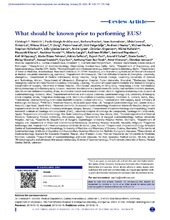What should be known prior to performing EUS?
Dietrich, Christoph F.; Arcidiacono, Paolo Giorgio; Braden, Barbara; Burmeister, Sean; Carrara, Silvia; Cui, Xinwu; Di Leo, Milena; Dong, Yi; Fusaroli, Pietro; Gilja, Odd Helge; Healey, Andrew J.; Hocke, Michael; Hollerbach, Stephan; Garcia, Julio Iglesias; Ignee, André; Jürgensen, Christian; Kahaleh, Michel; Kitano, Masayuki; Kunda, Rastislav; Larghi, Alberto; Möller, Kathleen; Napoleon, Bertrand; Oppong, Kofi W.; Petrone, Maria Chiara; Saftoiu, Adrian; Puri, Rajesh; Sahai, Anand V.; Santo, Erwin; Sharma, Malay; Soweid, Assaad; Sun, Siyu; Teoh, Anthony Yuen Bun; Vilmann, Peter; Jenssen, Christian
Peer reviewed, Journal article
Published version

Åpne
Permanent lenke
https://hdl.handle.net/1956/21624Utgivelsesdato
2019-02-14Metadata
Vis full innførselSamlinger
Originalversjon
https://doi.org/10.4103/eus.eus_54_18Sammendrag
Direct referral of patients for EUS – instead of preprocedural consultation with the endosonographer – has become standard practice (like for other endoscopic procedures) as it is time- and cost-effective. To ensure appropriate indications and safe examinations, the endosonographer should carefully consider what information is needed before accepting the referral. This includes important clinical data regarding relevant comorbidities, the fitness of the patient to consent and undergo the procedure, and the anticoagulation status. In addition, relevant findings from other imaging methods to clarify the clinical question may be necessary. Appropriate knowledge and management of the patients' anticoagulation and antiplatelet therapy, antibiotic prophylaxis, and sedation issues can avoid unnecessary delays and unsafe procedures. Insisting on optimal preparation, appropriate indications, and clear clinical referral questions will increase the quality of the outcomes of EUS. In this paper, important practical issues regarding EUS preparations are raised and discussed from different points of view.
